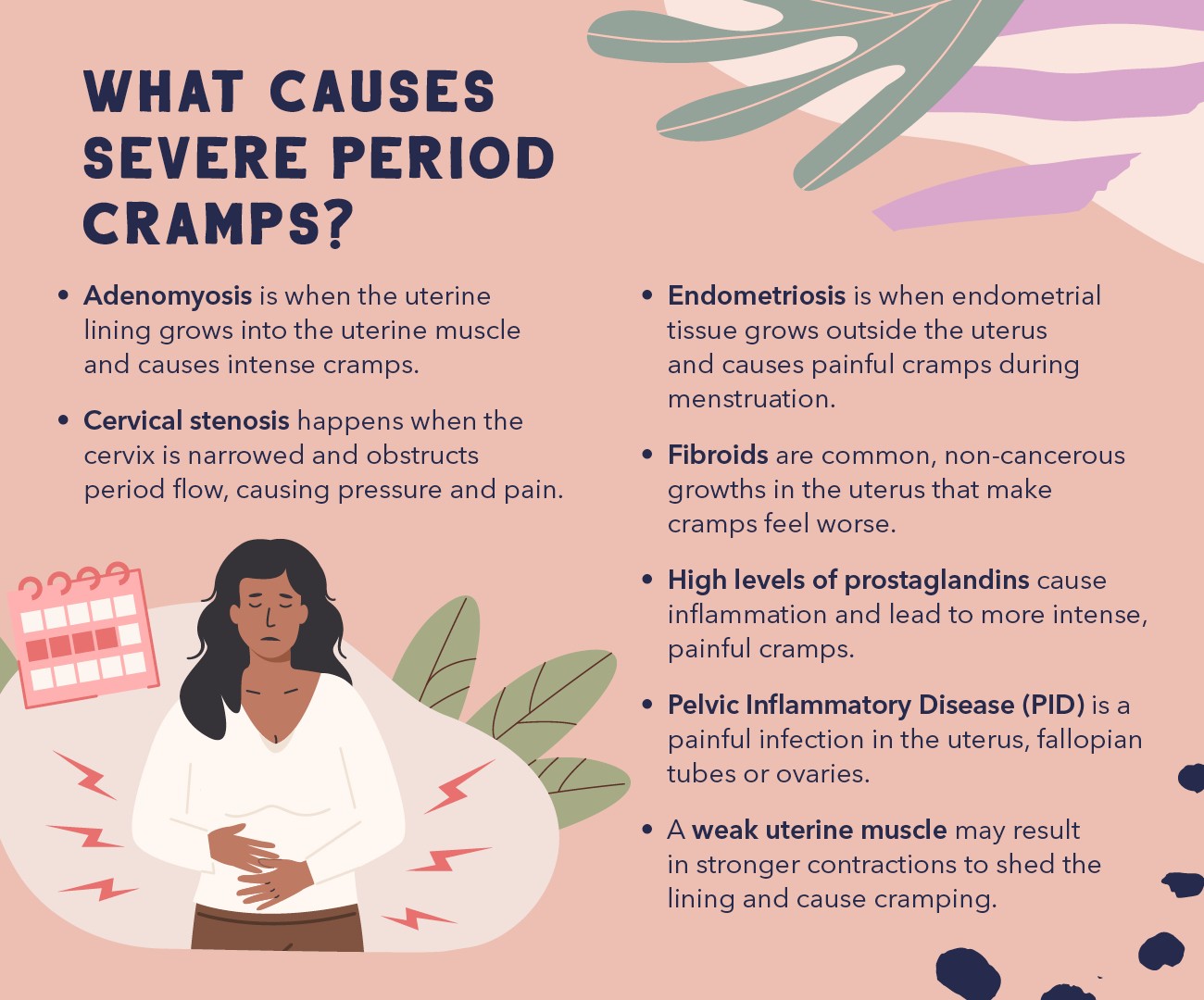Every month, many women experience the unwelcome arrival of period cramps. While some level of discomfort is considered a normal part of menstruation, excruciating pain that throws your life into disarray is not something you simply have to accept. Let’s delve into the reasons behind debilitating period cramps and explore effective ways to find relief.
Decoding the Mystery of Severe Period Cramps
Menstrual cramps, medically known as dysmenorrhea, occur when your uterus contracts to shed its lining. These contractions are triggered by hormone-like substances called prostaglandins. While some prostaglandins are necessary for this process, an overproduction can lead to more intense uterine contractions and heightened pain. This pain is typically felt in the lower abdomen and pelvic region and can sometimes radiate to the lower back and thighs.
However, when period cramps become severely painful, there might be underlying factors at play. Several conditions can exacerbate menstrual pain, turning normal cramps into an unbearable monthly ordeal:
- Adenomyosis: In this condition, the uterine lining begins to grow into the muscular wall of the uterus. This misplaced tissue can lead to significantly more painful and heavy periods.
- Cervical Stenosis: A narrowing of the cervix, known as cervical stenosis, can obstruct the flow of menstrual blood. This obstruction increases pressure within the uterus, resulting in intensified pain.
- Endometriosis: Endometriosis is a condition where tissue similar to the uterine lining grows outside the uterus. This misplaced tissue can attach to organs like the ovaries, fallopian tubes, and even the bowel. Endometriosis is a major cause of severe period pain, as this tissue behaves like uterine lining, thickening and bleeding with each cycle, causing inflammation and pain.
- Uterine Fibroids: These noncancerous growths in the uterus are quite common, but they can contribute to heavier bleeding and more painful cramps. Fibroids can distort the uterus and increase uterine contractions, leading to intensified pain.
- High Prostaglandin Levels: As mentioned earlier, prostaglandins play a key role in period cramps. Women with excessively high levels experience stronger uterine contractions and increased inflammation, resulting in more severe pain.
- Pelvic Inflammatory Disease (PID): PID is an infection of the female reproductive organs, often caused by sexually transmitted infections. It can lead to chronic pelvic pain and significantly worsen period cramps.
- Weak Uterine Muscle: Paradoxically, a weaker uterine muscle may need to contract more forcefully to expel the uterine lining. These stronger contractions can translate to more intense cramping.
It’s important to note that many of these conditions, beyond causing severe cramps, can also manifest as irregular periods or abnormal bleeding. If you observe a noticeable increase in the severity of your period cramps, especially if accompanied by irregular bleeding, consulting your healthcare provider is crucial.
 Illustration depicting various causes of severe period cramps within the female reproductive system, including endometriosis, fibroids, adenomyosis, PID, cervical stenosis, and high prostaglandin levels.
Illustration depicting various causes of severe period cramps within the female reproductive system, including endometriosis, fibroids, adenomyosis, PID, cervical stenosis, and high prostaglandin levels.
Differentiating Normal Cramps from Debilitating Pain
Understanding what “normal” period cramps feel like can help you gauge the severity of your own pain. Typical menstrual cramps are felt in the pelvis and sometimes radiate to the lower back and upper thighs. They are characterized by:
- A tightening sensation in the pelvic muscles
- Bloating
- Aching pain
- Sometimes, nausea
- Pain that can be sharp, dull, or intermittent
These cramps usually start shortly before your period and can last for the first 1-3 days of menstruation, often easing as your period progresses. However, severe cramps can persist throughout your entire cycle, significantly impacting your daily life.
Why Do Some Women Experience Excruciating Period Cramps?
The intensity of period cramps varies significantly among women. While prostaglandins are a primary culprit, individual differences in pain perception, uterine sensitivity, and the presence of underlying conditions contribute to this variation. If you find yourself experiencing period cramps so severe that they are debilitating, hindering your ability to perform daily activities, it’s a clear signal to seek medical advice.
As Kristen Larter, ARNP, WHNP, UnityPoint Health, advises, “If you’re having horrible period cramps, so bad you can’t move, see a provider. You could have an underlying condition that causes severe period cramps. These can include, but aren’t limited to, endometriosis, fibroids, polyps, infections, pelvic inflammatory disease or ovarian cysts.” Ruling out these conditions is crucial for effective management and long-term relief.
Cramps Without Period: What Could Be the Reason?
Experiencing cramps even when your period hasn’t arrived can be confusing. It’s possible that your period is simply delayed and will start soon. However, pelvic cramping without menstruation can also stem from other factors, such as:
- Pelvic infections
- Ovarian cysts
- Constipation
- Pregnancy
Distinguishing between period cramps and pregnancy cramps can be tricky. Larter notes, “Period cramps typically feel stronger than pregnancy cramps.” If you suspect you might be pregnant or have missed your period, taking a pregnancy test is recommended to confirm.
Effective Home Strategies for Severe Period Cramp Relief
Fortunately, several home remedies and lifestyle adjustments can provide significant relief from severe period cramps. What works best often varies from person to person, but these are generally effective strategies:
- Over-the-counter pain relievers: Medications like ibuprofen, naproxen, and combination drugs such as Midol are effective in reducing period pain. For severe cramps, a higher dose of ibuprofen (up to 800 mg every 8 hours with food, for a maximum of five days) can be taken, but it’s crucial to be aware of contraindications, especially if you have stomach or digestive issues. Naproxen is typically taken in doses of one or two tablets every 12 hours.
- Heat therapy: Applying a heating pad to your lower abdomen or back can effectively relax uterine muscles and alleviate pain. Warm baths can offer similar soothing benefits.
- Exercise: Regular physical activity, even gentle exercise during your period, can help release endorphins, which have natural pain-relieving effects.
- Soothing Teas: Certain herbal teas, like ginger, chamomile, and peppermint, possess anti-inflammatory and muscle-relaxant properties that can ease cramps.
- Dark Chocolate: Some studies suggest that dark chocolate, rich in magnesium, can help relax muscles and reduce period cramps.
- Anti-inflammatory Diet: Incorporating foods with anti-inflammatory properties, such as fruits (bananas, berries, citrus fruits, watermelon), vegetables (broccoli, kale), whole grains, nuts, and seeds, may help reduce overall inflammation and alleviate cramp severity.
When to Seek Medical Attention for Period Cramps
While home remedies can provide relief, severe period cramps warrant a visit to your healthcare provider. It’s essential to discuss your options, including hormonal birth control methods that can help manage cramps, and to investigate any potential underlying conditions. Consult your doctor if you experience any of the following:
- Severe cramps with every period
- Pain between periods
- Heavy periods accompanied by bad cramps
- Cramps causing nausea, vomiting, or other concerning symptoms
- Period cramps that force you to miss work, school, or social engagements
Don’t hesitate to talk to your provider about your period pain. Effective treatments are available, and addressing underlying conditions is crucial for your overall well-being. You can easily find a doctor or access your patient portal through MyUnityPoint for convenient communication and care management.
